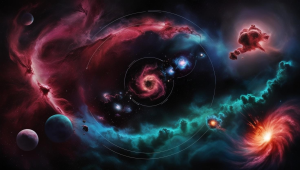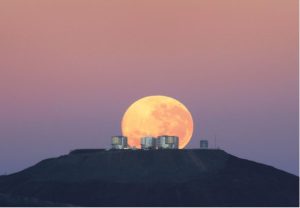
WORMHOLES:COSMIC SHORTCUTS
What if you could rocket from Earth, not to the Moon or Mars, but down a wormhole that loops all the way across the vast Milky Way, slashing travel time
If you could tune your radio to the perfect frequency and filter out all other noise sources, you would be able to pick up the faint whispers of the cosmic microwave background (CMB) radiation from every corner of the universe. This ancient light represents the oldest observable relic from the tremendous cosmic fireball that marked the beginning of our universe almost 14 billion years ago.
The Cosmic Microwave Background Explained:
In the first few moments after the Big Bang, the universe was incredibly hot and dense, filled with a fiery maelstrom of particles and high-energy radiation. As the universe rapidly expanded and cooled, particles slowed down and lost energy, allowing the first stable atoms (mostly hydrogen) to form around 380,000 years after the Big Bang. This phase transition released a tremendous amount of radiation, which has continued traveling virtually unimpeded throughout the expanding cosmos ever since.
Over the eons, this primordial radiation has cooled dramatically due to the relentless expansion of space itself, shifting from infrared to microwave wavelengths. Today, this ancient light bathes the universe in cold ambient radiation with a temperature just under 3 Kelvin (-454F/-270C). While invisible to our eyes, specialized microwave detectors can map out this cosmic microwave background in exquisite detail.
Afterglow from the Big Bang:
The study of the cosmic microwave background has provided some of the most compelling evidence for the Big Bang theory of cosmology. The extraordinary smoothness and isotropy (same temperature in all directions) of the CMB is exactly what would be expected from radiation that has been stretching with the expansion of space for over 13 billion years. Any irregularities or preferential directions would have been smoothed out long ago.
Additionally, the specific black body form of the microwave background spectrum precisely matches calculations for cooled radiation from an ultra-hot dense phase. The temperature of this radiation also provides an important estimate for the age and expansion rate of the universe based on how much this light has cooled over cosmic time.
Tiny Temperature Variations
While the CMB radiation is remarkably uniform overall, there are tiny variations in its temperature from one part of the sky to another at about one part in 100,000. These small anisotropies directly encode the primordial density variations that acted as the seeds for all structure in the universe. Regions that started off slightly denser pulled in more matter under their own gravity, growing into the galaxies, clusters, and cosmic web we see today.
Mapping these minuscule temperature fluctuations in the CMB has allowed cosmologists to deduce a tremendous amount of information about the overall composition and evolution of the universe. The specific patterns and scales of CMB hot and cold spots reveal important parameters such as the density of matter, the geometry of space, and even details about what type of particles and fields dominated in the ultra-hot early universe.
Cosmic Serendipity:
The discovery of the cosmic microwave background radiation was actually somewhat serendipitous. In the 1960s, Arno Penzias and Robert Wilson were researchers at Bell Telephone Laboratories trying to eliminate all sources of noise in a specialized microwave receiver. However, no matter what they tried there was always an excess low-level signal that appeared to be coming from every direction across the sky.
After thoroughly checking their equipment and covering their receiver horn with absorbing material, Penzias and Wilson concluded that this noise was coming from outside our own galaxy. Around the same time, cosmologists at Princeton University including Robert Dicke and Jim Peebles had been working on theoretical concepts for remnant radiation from the Big Bang. Putting the observational and theoretical pieces together, Penzias and Wilson had stumbled across the cosmic microwave background – a tremendous validation for Big Bang cosmology.
Modern Observations:
Since its initial discovery, increasingly sophisticated microwave detectors and space-based observatories have mapped the cosmic microwave background with remarkable precision. NASA’s Cosmic Background Explorer (COBE) satellite in the 1990s first revealed the faint hot and cold spots that would prove so pivotal in understanding the evolution of cosmic structure.
Most recently, the Planck Space Observatory has produced incredibly high-resolution all-sky maps of the CMB at multiple microwave frequencies from 2009 to 2013. These cutting-edge measurements have provided the tightest constraints yet on cosmological parameters, as well as revealing some tantalizing puzzles and anomalies at the largest observable scales that could potentially point toward new physics.
Researchers continue to refine their observations and analysis to glean ever more detailed information from this ancient light. Future CMB experiments may be able to detect the signature of primordial gravitational waves and probe the first moments just after the Big Bang. The cosmic microwave background has revealed the universe on its grandest scales and provides an irreplaceable window into the hot dense birth of our cosmos.

What if you could rocket from Earth, not to the Moon or Mars, but down a wormhole that loops all the way across the vast Milky Way, slashing travel time

If you go outdoors on a clear evening and also search for it, you might have the ability to see Jupiter beaming brilliantly amongst the celebrities. At the exact same

Stars, the dazzling points of light that fill up the evening skies are the foundation of galaxies plus the cradles of life itself. From their birth in large clouds of

In the mission to recognize deep space mankind has actually developed progressively effective devices to observe deep space. Completion of this venture is the Extremely Large Telescope (ELT) which is

Space debris, also known as space junk, refers to the defunct artificial objects orbiting Earth. These objects include decommissioned satellites, spent rocket stages, and fragments from collisions and explosions.

The search for exoplanets– planets that orbit stars outside our planetary system– has actually quickly developed into one of the most interesting and dynamic fields of astronomy
Write to
Jasmine Gogoi at csr@scientifictemperament.com
Let’s develop our society with a scientific heart. Join us to build the scientifically nurtured future →